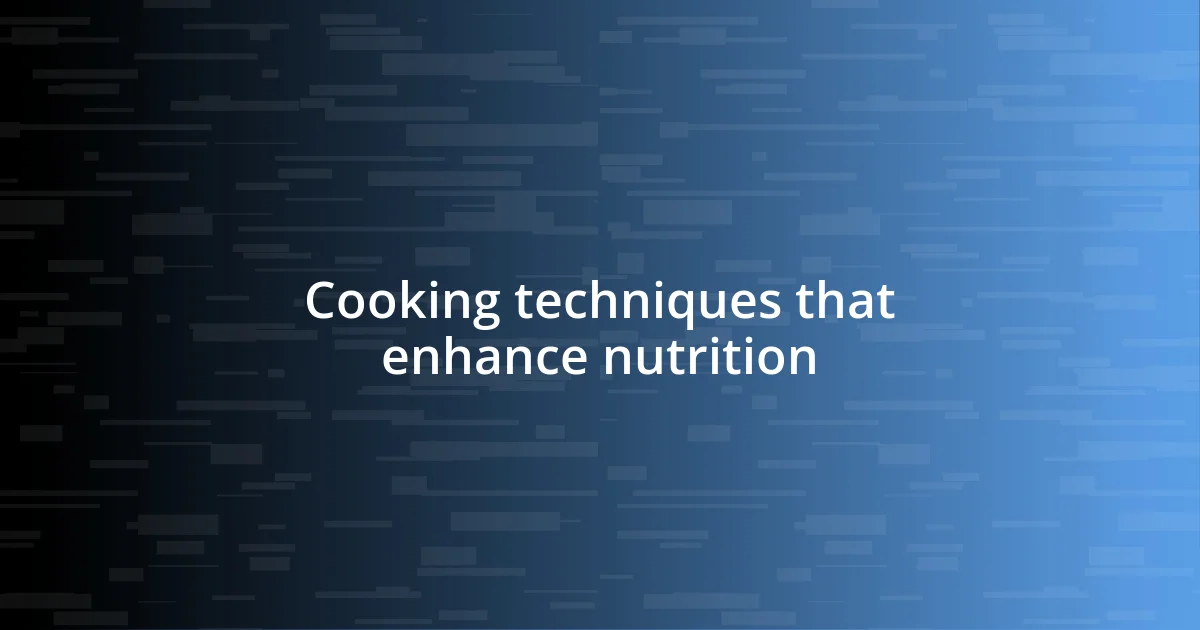Key takeaways:
- Incorporating a variety of nutrient-rich foods, including complex carbohydrates, healthy fats, and lean proteins, is essential for maintaining energy levels throughout the day.
- Meal planning and preparation, such as batch cooking and choosing healthy snacks, significantly enhance sustained energy and help avoid unhealthy last-minute food choices.
- Cooking techniques like steaming, sautéing, and roasting can boost both the nutritional value and flavor of meals, making them more enjoyable and energizing.

Understanding energy-boosting foods
When I think about energy-boosting foods, I often recall the mornings fueled by a hearty bowl of oatmeal topped with fresh berries. Oatmeal, rich in complex carbohydrates and fiber, provides steady energy that keeps me going throughout busy mornings. Isn’t it amazing how something as simple as a warm bowl can set the tone for a productive day?
I’ve found that incorporating foods like nuts and seeds into my snacks can really make a difference in my energy levels. For instance, when I reach for a handful of almonds, I’m not just enjoying a tasty treat; I’m feeding my body healthy fats and protein that stave off the afternoon slump. Do you ever notice how certain snacks can either uplift you or leave you feeling sluggish? It’s like tuning into your body’s unique rhythm.
On particularly long days, I’ve turned to vibrant green smoothies brimming with spinach and bananas. The combination of vitamins, minerals, and natural sugars feels revitalizing—as if I’m sipping pure energy. I don’t know about you, but when I choose nutrient-rich foods, I feel more alive and engaged. It’s a beautiful reminder of how vital our choices are in shaping our day-to-day vitality.

Nutritional balance for energy
When I think about nutritional balance for energy, the first thing that strikes me is the importance of providing my body with a variety of nutrients. For example, when I prepare a meal, I always strive to include a balance of carbohydrates, proteins, and fats—allowing my body to harness energy efficiently. The vibrant colors on my plate not only make meals visually appealing but are also a signal of the diverse nutrients I’m providing. Can you remember the last time you felt energized after a meal because of its nutritional variety?
I’ve learned that timing matters as much as what I eat. Eating small, balanced meals or snacks every few hours keeps my energy levels steady throughout the day. I’ll often opt for a whole grain toast with avocado and a sprinkle of seeds. Honestly, there’s something about how this combination keeps my energy flowing while preventing that dreaded mid-afternoon crash. It’s curious how some foods can perfectly fuel our dynamic lives while others seem to bring everything to a halt.
To illustrate further, let’s consider a comparative view of food choices regarding their nutritional balance for energy:
| Food Type | Nutritional Benefits |
|---|---|
| Complex Carbohydrates | Steady energy release due to fiber content (e.g., oatmeal, quinoa) |
| Healthy Fats | Supports brain function and keeps energy levels stable (e.g., avocados, nuts) |
| Lean Proteins | Helps sustain energy and maintain muscle (e.g., chicken, legumes) |
| Fruits and Vegetables | Packs vitamins and minerals for overall vitality (e.g., spinach, bananas) |

Meal planning for sustained energy
Meal planning plays a crucial role in maintaining sustained energy throughout the day. I’ve often found that taking a little time each week to plan my meals not only helps me save time but also supports my overall energy levels. For example, when I prepare a batch of quinoa and roast a variety of vegetables, I have nutritious options ready to go, making it much easier to avoid energy dips caused by unhealthy last-minute choices.
When planning your meals, consider incorporating the following strategies:
- Focus on Variety: Aim to include different fruits, vegetables, proteins, and grains to ensure diverse nutrients.
- Batch Cooking: Cook larger quantities on weekends to have quick, healthy meals available.
- Healthy Snacks: Prepare portable snacks like homemade energy bars or veggie sticks with hummus to keep your energy up between meals.
- Hydration: Don’t forget to plan for hydration; herbal teas or infused water can also be energizing.
- Flexibility: Allow for some spontaneity in your meal plan to enjoy seasonal foods and unexpected cravings.
By taking these steps, I’ve felt the difference in my energy levels, especially during busy weekdays. It’s a wonderful feeling to open the fridge and see a colorful array of meals all set—like a little treasure chest waiting to fuel my day.

Cooking techniques that enhance nutrition
One of my favorite cooking techniques that enhances nutrition is steaming. I remember the first time I tried it with broccoli; the vibrant green color was captivating, and it retained all those essential vitamins. Steaming not only keeps the veggies crisp but also maximizes their nutrient content by minimizing exposure to heat and water. Have you ever noticed how flavor bursts in your mouth when you bite into perfectly steamed vegetables?
Another approach I cherish is sautéing with healthy oils, like olive or avocado oil. When I whip up a stir-fry, it’s not just about getting the meal on the table quickly; it’s about how I gently coax out the flavors of garlic and spices while allowing the veggies to maintain their nutrients. I play around with different herbs, and sometimes, I wonder if it’s the garlic that adds a magical touch to the dish or if it’s simply my love for cooking shaping my perception. Have you considered how different techniques can transform both flavor and nutrition?
Lastly, I can’t emphasize enough the power of roasting. There’s something truly magical about the way vegetables caramelize and develop depth when roasted in the oven. I recall making roasted sweet potatoes once, drizzled with a hint of cinnamon. They turned out so delicious that I found myself sneaking bites straight off the baking sheet! Roasting not only enhances flavors, but it also concentrates the nutrients—making even the simplest dish feel luxurious and satisfying. Could there be a better way to enjoy a nutrient-packed meal while indulging our taste buds at the same time?

Recipes for quick energy meals
When I whip up a smoothie bowl for breakfast, I feel instantly energized. I blend a banana, a handful of spinach, and some frozen berries for a vibrant treat that’s not only quick to prepare but also packed with vitamins. Top it off with a sprinkle of granola or a dollop of nut butter, and it’s like eating dessert for breakfast—who doesn’t love that? This meal leaves me feeling bright and ready to tackle the day ahead.
A go-to recipe for lunch is a chickpea salad that comes together in minutes. I mix canned chickpeas, chopped cucumber, cherry tomatoes, and parsley, then drizzle it with olive oil and lemon juice. Every bite bursts with freshness, and I can customize it based on whatever I have on hand. I once shared this with a friend during a busy workweek, and we both couldn’t stop raving about how such simple ingredients created a hearty, satisfying meal. Isn’t it incredible how a little creativity can breathe life into everyday foods?
For an energizing dinner, I love making a quinoa-stuffed bell pepper. I cook up some quinoa, mix in black beans, corn, and spices, then stuff the mixture into halved bell peppers and bake until tender. Each pepper is like a little package of goodness, and the colors remind me of a summer garden. Just the aroma wafting through my kitchen lifts my spirits. Isn’t it amazing how cooking can be a way to reconnect with vibrant moments in our lives?

Incorporating superfoods into meals
Incorporating superfoods into my meals is like sprinkling a bit of magic onto my plate. For instance, whenever I add chia seeds to my smoothies, I can’t help but smile thinking how just a small spoonful packs such a powerful punch of omega-3 fatty acids and fiber. It’s intriguing how a tiny seed can provide so much energy! Have you ever noticed how such little additions can elevate a dish from ordinary to extraordinary?
When I whip up a bowl of oatmeal, I don’t just stop at the classic toppings; I dive into the world of superfoods. I love to blend in some almond butter and sliced bananas, then top it off with goji berries for that sweet, chewy surprise. The burst of flavor I experience with each bite is delightful, but the extra nutrition is what keeps me grounded throughout the morning. It makes me wonder—are you missing out on the simple joys that superfoods can bring to your breakfast?
I also enjoy incorporating dark leafy greens like kale into my dinners. One night, I sautéed kale with garlic, and the aroma filled my kitchen, lifting my spirits. Tossing in some sautéed mushrooms not only added depth but also infused the dish with nutrients. Every forkful was a reminder of how nourishing meals can be both satisfying and vibrant. Have you ever thought about how a simple tweak, like adding kale to your stir-fry, can change your entire experience of a meal?

Adjusting meals for energy needs
Adjusting meals to meet energy needs is a fascinating journey I love to explore. For example, when I feel like I need an extra boost during a long day, I find myself leaning towards meals that combine carbohydrates with protein. Just the other day, I prepared a whole-grain wrap with turkey, avocado, and plenty of colorful veggies. The combination filled me up without weighing me down, and I could feel the difference in my alertness for that afternoon meeting.
I’ve learned that the timing of my meals plays a huge role in my overall energy levels. On busy days, I make it a point to snack smartly between meals. One afternoon, I packed homemade energy balls made from oats, nut butter, and a touch of honey. They’re quick to make and incredibly satisfying. When I reached for one, it felt like I was giving myself a little gift of energy rather than reaching for sugary snacks that just crash my mood later. How do you ensure your snack choices keep your energy high throughout the day?
Moreover, I’m convinced that the colors on my plate matter just as much as the ingredients. The other evening, I made a vibrant stir-fry with red bell peppers, broccoli, and carrots. Each bite was a celebration of flavors, and I felt this uplifting energy with every crunch. It’s amazing how the visual appeal and the nutritional diversity create a meal that’s not just about sustenance but about joy and vitality. Have you noticed how adding more colors can brighten not just your plate, but also your energy levels?














